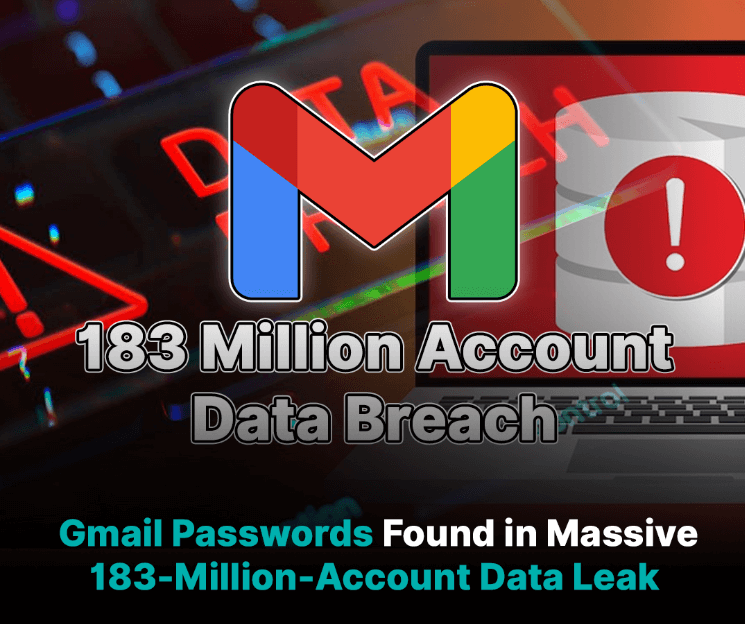183 Million Gmail Account Data Leaked ! Secure Your Account Now
Margot Robbie | October 29th, 2025 | Gmail
In a shocking turn of events, reports have surfaced that a massive 183 million Gmail account data leaked online. This massive leak has raised serious concerns about user privacy and account safety worldwide. While Google has officially denied any direct breach of its Gmail servers, this leak still puts millions of users at risk due to reused or stolen credentials.

If you use Gmail or have ever reused your passwords across different websites, it’s time to check the safety of your mailbox and take immediate action to secure your account. In this post, we’ll explain what happened, why it matters, how you can quickly check whether your Gmail account has been compromised, and the crucial steps you must take to secure your account immediately.
What Google Says About 183 Million Email Password Leak?
Cybersecurity researchers recently discovered a huge compilation of 183 million unique email and password combinations posted on hacker forums. Google clarified that there has been no breach of Gmail’s servers. The company continuously monitors for compromised credentials and automatically prompts users to change passwords if it detects suspicious activity. Their statement emphasizes that the 183 million Gmail account data leak wasn’t the result of a direct hack into the Gmail server, but rather a compilation of stolen data from different sources:
- Malware-infected systems
- Phishing campaigns
- Previously hacked websites and data dump
This means your Gmail password could still be exposed even if Gmail itself wasn’t directly hacked.
Why You Should Be Concerned About Your Gmail Account?
Your Gmail account is more than just an email inbox. It also contains your Google Drive, Photos, banking alerts, and personal data. If compromised, cybercriminals could gain access to multiple linked accounts, leading to identity theft, data loss, or even financial fraud.
Even though Gmail itself wasn’t directly hacked, the incident poses a serious security risk for users who:
- Use the same password across different websites
- Have weak or guessable passwords
- Haven’t enabled two-factor authentication
- Have ignored security alerts from Google
How to Check if Your Account Was Affected by 183 Million Gmail Account Data Leaked?
There are some ways to verify your Gmail account’s safety.
1. Check with Have I Been Pwned
- Visit Have I Been Pwned.
- Enter your Gmail address in the search box.
- The site will tell you if your email address has appeared in any known breaches.
- If your Gmail account appears in a leak, then immediately change your password.
2. Use Google’s Built-in Password Checker
Google offers a built-in Password Manager that automatically checks your saved credentials for breaches. To do it:
- Visit passwords.google.com.
- Click Check Passwords.
- Google will show if any of your passwords were compromised, weak, or reused.
This feature makes it easy to secure your Gmail and other connected accounts.
3. Review Recent Gmail Login Activity
- Open Gmail.
- Scroll down in your inbox and click on Details.
- Now, you’ll see the last login activity, including IP address and device location.
- If you find any unfamiliar sign-ins, click Sign out of all other sessions.
4. Check Security Alerts from Google
Google often sends alerts if it detects suspicious sign-ins or password leaks.
How to Secure Your Gmail Account Now?
The 183 million Gmail account data leak serves as a wake-up call for every Gmail user. Your Gmail account holds your personal, professional, and financial information, so don’t wait until it’s too late to protect it. Follow the steps to secure your Gmail account data immediately:
1. Change Your Password
Choose a strong, unique password and never reuse passwords from other websites. Also, use a password manager for secure storage.
2. Enable Teo-Step Verification
This extra layer prevents hackers from logging in even if they know your password. Go to Google Account -> Security -> 2-step verification. Enable Google Authentication, SMS codes, or Passkeys.
3. Update Recovery Options
Remove outdated recovery details and add an active recovery email & phone number. This helps you regain access if your account is compromised.
4. Revoke Suspicious App Access
Visit Security -> Third-party apps with account access and remove apps you don’t recognize or use anymore.
5. Keep Your Device Secure
Regularly scan for malware or keyloggers. Avoid saving passwords on public or shared computers.
Bonus Tips to Increase Gmail Security
Even after changing your passwords and enabling 2FA, regularly back up your Gmail account data to ensure long-term protection. If a hacker locks you out of your Gmail account or Google suspends access for security reasons, you could lose critical data. To prevent it, you must have a backup copy of your Gmail account to get them easily in the event of any uncertainties. Try the Advik Gmail Backup Tool, which is a reliable and secure utility. With this tool, you can download Gmail emails to hard drive/PC/computer.
This software allows you to:
- Save the entire Gmail mailbox at once.
- Allows selective email backup by date, subject, etc.
- Preserves data integrity and folder hierarchy.
- Export Gmail to PST, PDF, MBOX, EML, etc.
- Backup multiple Gmail accounts in one go.
- Simple user graphical interface.
You can download its free demo version to check its working procedure.
Conclusion
The 183 million Gmail account data leaked serves as a wake-up call for every internet user, especially for Gmail users. Even if Gmail wasn’t directly hacked, your data could still be exposed if you reuse passwords or neglect account protection features.
By taking the right steps – changing your passwords, enabling 2FA, reviewing account access, and backing up your Gmail data- you can protect your valuable emails and digital identity from future threats.

